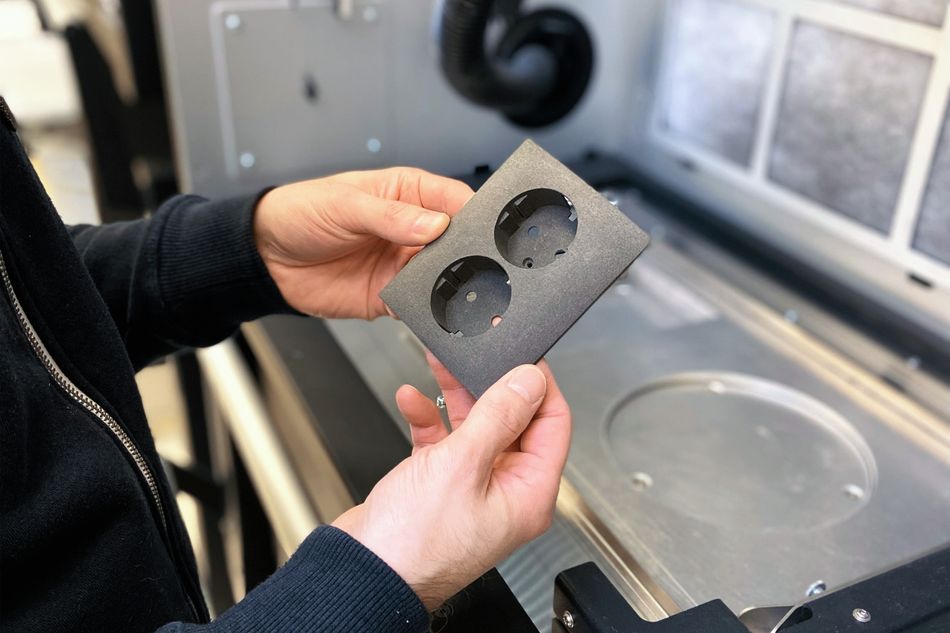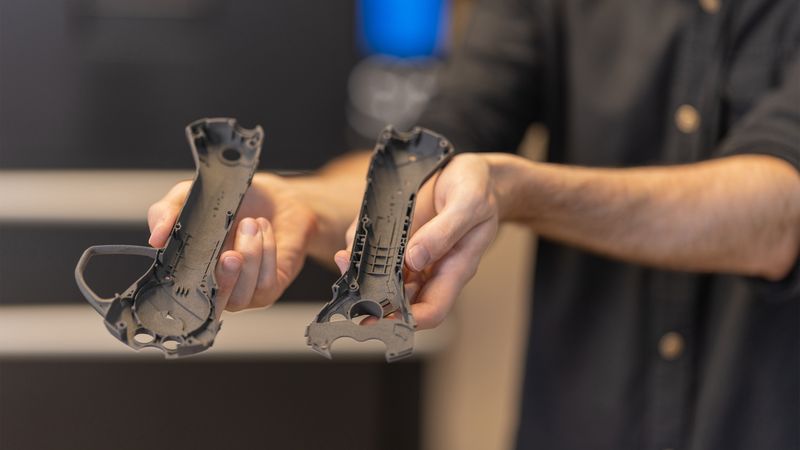Sintratec's Laser Spot Size The Key to Superior Print Resolution
Sintratec's high-precision lasers with smaller spot sizes allow for superior print resolution and finer details in SLS 3D printing.
Selective laser sintering (SLS) 3D printing is considered one of the most reliable and productive forms of additive manufacturing.[1] Recently, advances in hardware are improving SLS printing even further, enabling even better surface finish quality and achievable level of fine details.
At Sintratec, a Swiss maker of professional SLS systems, these advances are in the form of high-precision lasers with spot sizes significantly smaller than other entry-level SLS systems. This has enabled Sintratec to achieve unparalleled print resolutions and feature sizes on its SLS platforms. In this article, we look at what laser spot size is, how it influences print resolution, and how Sintratec’s technologies are unlocking new opportunities for SLS users.
The Science of Laser Spot Size
Selective Laser Sintering is an additive manufacturing technique that fabricates parts by sintering powdered material using a laser. The process begins by depositing a thin layer of polymer powder onto a build platform. A high-powered laser then selectively scans the surface, melting and fusing the powder according to the cross-sectional geometry of the part being built. On the completion of one print layer, the build platform descends incrementally, and a new layer of powder is spread across the surface, repeating the sintering process. This layer-by-layer approach continues until the part is complete. [2]
While there are different types of lasers that can be used in the SLS process, one of the most common is Fiber Lasers. These lasers generate light through diodes that pump energy into a fiber optic cable doped with rare-earth elements such as ytterbium. The resulting light typically has a wavelength of about 1,060 nm, which offers high absorption rates in metals and certain polymers. This characteristic makes fiber lasers highly effective for the precision melting of polymer and metal powders. Advantages of fiber lasers in SLS include their excellent beam quality, energy efficiency, and minimal maintenance requirements. [3]
When evaluating laser performance in SLS printing, laser spot size is one of the most important specifications. In short, laser spot size (also known as laser beam diameter) is defined as the smallest diameter that a laser can be focused to with a lens. One major reason why laser spot size is so valuable is because it directly influences the laser energy density, which determines the precision and quality of the sintered parts by affecting the melt pool size, depth of penetration into the powder bed, and overall resolution of the final product. Laser energy density is defined as [4]

Where:
Eₛ is the laser energy density (J/cm^2)
P is the incident laser power (Watts)
v is the laser scan speed (cm/s)
δ is the laser beam spot size (cm)
The laser spot size itself can be defined and calculated in several different ways, but, in the case of SLS printers, spot size is generally defined by the full width at half-maximum (FWHM). Essentially, FWHM quantifies the beam's spread or divergence by measuring the distance between the two points on the intensity profile (a plot of light intensity versus position) at which the intensity falls to half of its peak value. [5]
There are many variables that impact the laser beam spot size. Assuming an ideal Gaussian beam, it’s well-defined that the beam width varies as it propagates along its axis. Therefore, the spot size at the focal length is determined by the focal length itself, the smallest radius of the Gaussian beam (i.e., beam waist), and the beam’s wavelength. Based on this, the spot size is mathematically defined as [6]

Where:
f is the focal length.
Wf is the beam radius focal length (i.e., spot size)
λ is the laser wavelength
w₀ is the beam waist
Ultimately, the laser spot size is an important factor that influences the resolution of printed components as well as properties like density, strength, and minimum feature size. In essence, the degree of detail an SLS 3D printer can achieve is determined by the laser spot size, and the minimum feature size typically corresponds to the laser spot size.
Impact of Laser Spot Size on Print Quality
When we talk specifically about resolution in 3D printing, there are two types of resolution to consider: the Z resolution and XY resolution. Z resolution is the vertical resolution that is dependent on the layer thickness of the print (i.e. how finely the recoater can spread each new layer of powder material). XY resolution, for its part, refers to the horizontal resolution of the print and is influenced by both laser spot size and the precision of the laser’s movement. [7]
A smaller laser spot size therefore directly corresponds to a higher XY print resolution and enables users to integrate very fine details and intricate features into their 3D prints. SLS 3D printers with smaller laser spots are also better equipped to print parts with superior surface finishes. Smaller laser spot sizes have been shown to decrease layer line height, resulting in less visible layer lines, smoother surfaces, and finer details in the printed objects. [8]
Research has found that smaller laser spot sizes markedly enhance the geometrical accuracy of printed tracks. [9] One reason for this is that a small spot size affords precise control over the dimensions of the melt tracks, including their width, height, and depth. As part of this, smaller spot sizes minimize the heat-affected zone around the melt tracks, reducing thermal deformations and residual stresses that can compromise the mechanical integrity of the final product.
Adjustments in laser power and scanning speed can significantly influence these parameters, enabling the creation of smoother surfaces and more defined track edges. Precise parameter control helps maintain stable melt pool dynamics, crucial for minimizing defects such as porosity and keyhole formation that degrade print quality.

Sintratec’s Unique Selling Proposition (USP)
Sintratec places an important emphasis on SLS printer laser spot size. The company’s machines boast some of the finest laser spot diameters and resolutions in the SLS 3D printing market today. The company’s newest fusion module for its All-Material Platform, the Sintratec S3, is equipped with a 30-watt fiber laser that is focused down to a spot size of just 145 μm. The S2, fitted with a 10-watt fiber laser, has the same laser spot size.
Sintratec’s laser spot diameter is substantially smaller than many other SLS platforms on the market. This opens applications for its technology in industries like aerospace and electronics that require not only high throughput and process consistency but also high resolution and part accuracy. You can find a comparison of some leading SLS systems below:
| SLS 3D Printer | Laser Spot Size (μm) |
| Sintratec S3 and S2 | 145 μm [10] |
| Prodways Promaker P1000 | 450 μm [11] |
| Sinterit Lisa X | 650 μm [12] |
| Formlabs Fuse 1 | 200 μm [13] |
Real-World Applications and Benefits
Adopters in various industries are already reaping the benefits of Sintratec’s high-resolution SLS solutions. Around the globe, its Swiss-made systems are leveraged by product developers, engineers, and researchers to create precise, functional prototypes that not only closely match the exact dimensions and shape of final parts, but also their mechanical properties. This application dramatically speeds up design validation and prototype testing, enabling users to move quickly and confidently into series production.
Kontakt-Simon SA, a major manufacturer of electric installation equipment, has been using the Sintratec S2 since 2022 to create complex, high-precision prototypes for the electrical sector. The accuracy of Sintratec’s fiber laser system has been vital in this application because printed parts are used to validate geometries and assemblies before moving into full-scale production. The high-quality surface finish of Sintratec prints, as well as the ability to produce complex shapes with fine details, has been important to Kontakt-Simon, since electric housings and components must not only fit electrical components of varying geometries within them but also fit perfectly into larger assemblies. When asked about the main benefits of the S2, Thomas Wilk, Head of Kontakt-Simon’s technical department, listed “complex geometries, thin walls, high aesthetics and accuracy, great strength, and homogeneity in each axis of the part.”

Swiss window maker Eschbal has also integrated the Sintratec S2 for a number of end uses, including prototyping, tooling, and small series production parts. Like Kontakt-Simon, the company values the technology’s ability to print parts that closely match the properties of injection molded parts. “With the SLS process, we were especially impressed by the tolerances of up to 0.1 millimeters and the surface quality,” comments Michael Ebnöther, a member of Eschbal’s tech department. For tooling and end-use parts, mechanical properties are paramount. For example, Eschbal optimized a connector component through SLS 3D printing, reducing the weight of the final part by 33%.
The case studies represent just a small fraction of the ways that Sintratec’s high-resolution 3D printers are being used. You can find more customer stories here.
Conclusion
Overall, laser spot size is an important piece of the SLS puzzle, influencing print properties like resolution. By focusing on precision through laser spot size, Sintratec has carved out a position for itself in the broader SLS market that caters to applications that require high print accuracy and fine details. In combination with SLS’ excellent throughput and consistency, the ability to achieve smaller features and ultimately better-quality prints takes the technology to another level.
References
1. Awad A, Fina F, Goyanes A, Gaisford S, Basit AW. 3D printing: Principles and pharmaceutical applications of selective laser sintering. Int J Pharm. 2020 Aug 30;586:119594. doi: 10.1016/j.ijpharm.2020.119594. Epub 2020 Jul 2. PMID: 32622811.
2. David L. Bourell, Trevor J. Watt, David K. Leigh, Ben Fulcher, Performance Limitations in Polymer Laser Sintering,Physics Procedia, Volume 56, 2014, Pages 147-156, ISSN 1875-3892, https://doi.org/10.1016/j.phpro.2014.08.157.
3. Liao, H, Le, MT, & Long, DV. "Optimization on Selective Fiber Laser Sintering of Bimetallic Powder via Design of Experiments Method." Proceedings of the ASME/ISCIE 2012 International Symposium on Flexible Automation. ASME/ISCIE 2012 International Symposium on Flexible Automation. St. Louis, Missouri, USA. June 18–20, 2012. pp. 475-482. ASME. https://doi.org/10.1115/ISFA2012-7232
4. Lü, L., Fuh, J.Y.H., Wong, Y.S. (2001). Selective Laser Sintering. In: Laser-Induced Materials and Processes for Rapid Prototyping. Springer, Boston, MA. https://doi.org/10.1007/978-1-4615-1469-5_5
5. J. Chalupský, J. Krzywinski, L. Juha, V. Hájková, J. Cihelka, T. Burian, L. Vyšín, J. Gaudin, A. Gleeson, M. Jurek, A. Khorsand, D. Klinger, H. Wabnitz, R. Sobierajski, M. Störmer, K. Tiedtke, and S. Toleikis, "Spot size characterization of focused non-Gaussian X-ray laser beams," Opt. Express 18, 27836-27845 (2010).
6. Oz Livneh, Gadi Afek, and Nir Davidson, "Producing an efficient, collimated, and thin annular beam with a binary axicon," Appl. Opt. 57, 3205-3208 (2018)
7. Anketa Jandyal, Ikshita Chaturvedi, Ishika Wazir, Ankush Raina, Mir Irfan Ul Haq, 3D printing – A review of processes, materials and applications in industry 4.0, Sustainable Operations and Computers, Volume 3, 2022, Pages 33-42, ISSN 2666 4127, https://doi.org/10.1016/j.susoc.2021.09.004.
8. M. Launhardt, A. Wörz, A. Loderer, T. Laumer, D. Drummer, T. Hausotte, M. Schmidt, Detecting surface roughness on SLS parts with various measuring techniques, https://www.sciencedirect.com/science/article/abs/pii/S0142941816302057
9. Vaglio E, De Monte T, Lanzutti A, Totis G, Sortino M, Fedrizzi L. Single tracks data obtained by selective laser melting of Ti6Al4V with a small laser spot diameter. Data Brief. 2020 Oct 22;33:106443. doi: 10.1016/j.dib.2020.106443. PMID: 33195769; PMCID: PMC7642809.
10. https://sintratec.com/sls-3d-printer/amp/sintratec-s2/
11. https://www.prodways.com/wp-content/uploads/2021/09/ProMaker-P1000-Series-EN-V19.08.2021.pdf
12. https://www.3d-printer.com/3D_Printers/Sinterit_Printers/lisa-x
13. https://formlabs.com/3d-printers/fuse-1/tech-specs/


